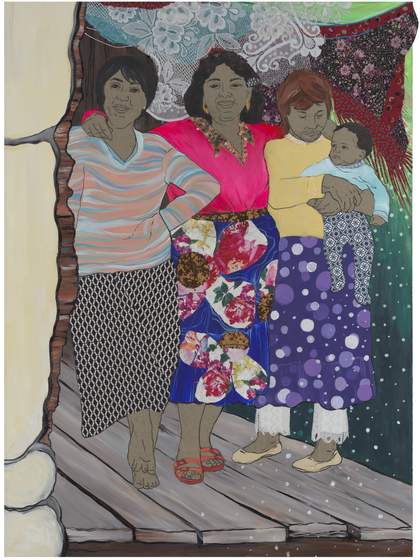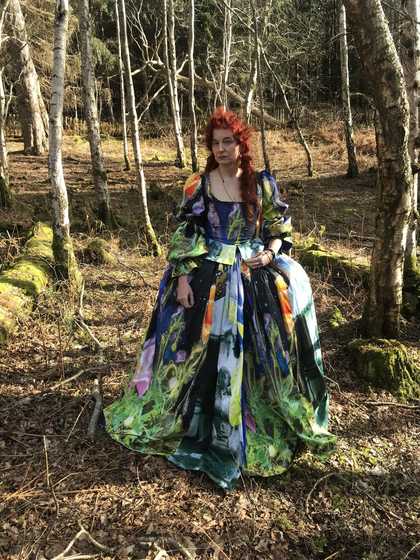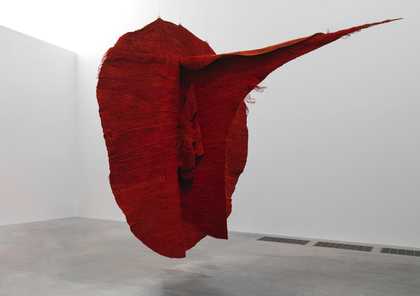Right now, fabric is my tool, the material I see myself in.
I always think of my work as a fabric collage but I also sometimes feel like I'm creating a relief and sometimes I catch myself calling it a painting in fabric, but it's not like that.
My name is Małgorzata Mirga-Tas.
I am a Polish Romani artist and I live in Czarna Góra.
After studying at the Academy of Fine Arts the main subject of my work was Roma history and culture.
The subjects were those closest to me at first, and then topics that concern the Roma community and that I wanted to learn and talk about.
I usually start my work with research by exploring museum collections and everything they have in the archives concerning the Roma community.
Often all it takes is one picture or one photo that just gives me a new idea or a new thought about what I could do.
-Here's another one, it's smaller.
-Your mum?
-Yes, my mum
-Hands and heads too. And that'll be stitched together
I also use my own archives but also the archives of my uncle Andrzej Mirga.
Our whole family is there. Most of them are no longer with us. But I can still tell their story, how important they were to us.
Some survived the Second World War and communism and we have stories about them and we can continue to pass this on to future generations about people who are no longer with us.
I am very grateful that I have these photos and that my uncle let me use them.
I don't usually show these photos in exhibitions.
I process what I see in the photograph but I don't show the original.
It's very important to me not to share it. I don't want to lose the trust of those who share their lives with me.
-Where is the green fabric? They have put it all together here. I can't find it now. These last two pieces. I found them here... Oh, there it is! Got it
The fact that I started sewing and creating work in fabric, it followed on from what was happening in my life.
My mother would sew clothes, my grandma would sew clothes.
So the fabric was a part of my life.
Being pregnant, I couldn't sculpt so I started painting first and using clothes that I no longer fit into for obvious reasons.
I'm a person who gets attached to certain things so it was just hard for me to part with beautiful clothes and colours and so on.
So I incorporated them into paintings and the paintings became part painting and part fabric.
That was the moment when fabric became my tool.
-Now, when we combine them together it looks like one fabric... Yes, that's right
-I'll stand here
-Do you have the corner pieces?
The materials you see in the studio are partly from people I know, clothes from my mother, from my sister, my aunts and so on.
Even my assistants bring stuff from their neighbours because they also know we need used clothes.
Every fabric that is given to me is special to me.
It carries the energy of that person but also the emotions.
The fabric itself is not as important as what is in the character, the person.
I think the stories and who they are and how they form part of the culture and how they fight for their identity... I think that's the most important thing.
I grew up in Czarna Góra. I wouldn't really want to live anywhere else.
Close to the Tatra Mountains... there's a forest, a river, nature.
I also have friends, family, so this place is very important to me.
There are three different communities living side by side: Spisz, Highlanders and Roma.
I know that we are part of the majority culture and that makes it richer for others. Is that how it is perceived by others?
I don't know. Sometimes I think not.
Since university thinking about how to become more visible, how not to be marginalised, how to counter stereotypes, how to counter antigypsyism has been key for me.
Living in a Roma district, having a Roma family, seeing what's going on, worrying about things, about the future of my children.
I can't let go of certain themes.
-Will your assistants be with you in the studio today?
-Yes, I should let them know when I'm about to leave
I often turn to 15th century, works from the 16th, 17th, 18th centuries.
Not a single one of these works has ever been created or told by the Roma.
It's always an image recreated by a non-Roma person which means it's something that this image has been appropriated.
It's fine if it's positive and if it's part of our history and culture but of course there are works that are negative, full of stereotypes, these are reproduced for centuries.
And so you have the impression that it is all a copy of a single work.
And then there are works that have certain narratives that are very racist, that are stigmatising for centuries and which show exactly why they hate us and why they were reproduced later.
You don't see names.
They always call them the same way.
Look.
This one, this is the image.
It's really beautiful, I think.
Of course, she's 'the Gypsy'.
I give them names like 'Madonna'.
That's why I reanimate the characters that I see in these images and I want to give them the dignity and respect that they deserve.
I think this is to counter discrimination and racism.
Living in our times it's not easy and you can't justbe passive about certain things and subjects.
Okay, that's it.
Artist and activist Małgorzata Mirga-Tas invited us into her studio to watch the creation of her vivid textile collages.
Mirga-Tas makes artwork using materials and fabrics that are mainly gathered from family and friends. Her visual storytelling comes from a feminist perspective and challenges stereotypical representations of Roma people.
She also re-imagines artworks across the centuries that have presented Roma identity in negative ways and transforms them into vibrant images imbued with strength and dignity.
Research supported by Hyundai Tate Research Centre: Transnational in partnership with Hyundai Motor



